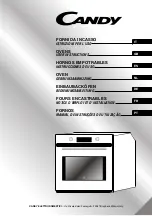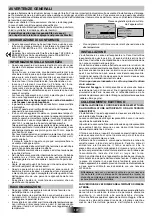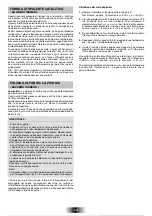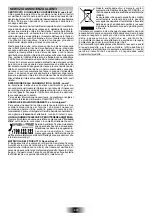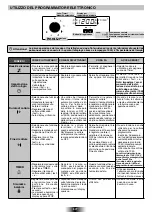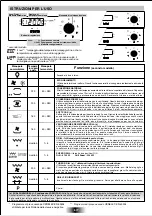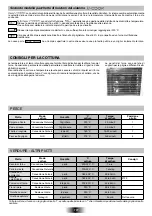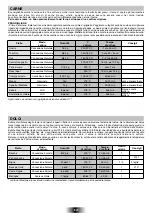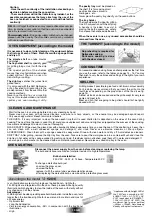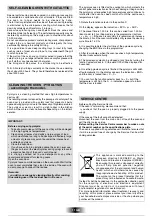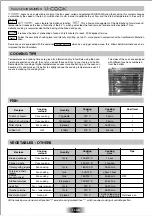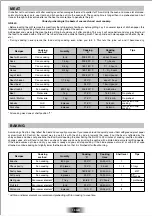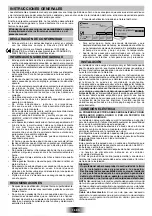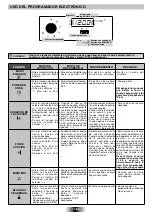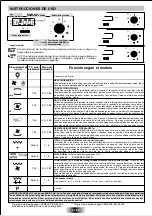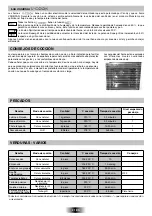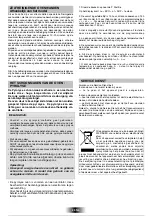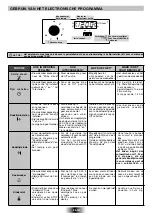
11 GB
SELF-CLEANING OVEN WITH CATALYTIC
Special self-cleaning panels covered in a micro-porous coating
are available as optional extras for all models. If they are fitted,
the oven no l onger needs to be cleaned by hand.
The fat that is splattered onto the sides of the oven during roasting
is eliminated by the microporous coating which breaks the fat
down by catalysis and transforms it into gas.
Excessive splattering may nevertheless block the pores and
therefore hinder self-cleaning. The self-cleaning capacity may be
restored by switching on the empty oven to maximum for about
10-20 minutes.
Do not use abrasive products, metal cleaning wads, sharp objects,
rough cloths, or chemical products and detergents that may
permanently damage the catalytic lining.
It is a good idea to use deep roasting trays to roast fatty foods
such as joints of meat etc. and to put a tray underneath the grill
to catch surplus fat.
If the walls of the oven are so thickly coated in grease that the
catalytic lining is no longer effective remove surplus grease with
a soft cloth or sponge soaked in hot water.
The lining must be porous for self-cleaning to be effective.
N.B.: All catalytic linings currently on the market have a working
life of about 300 hours. They should therefore be replaced after
about 300 hours.
SERVICE CENTRE
Before calling the Service Centre
If the oven is not working, we recommend that:
• you check that the oven is properly plugged into the power
supply.
If the cause of the fault cannot be detected:
disconnect the oven from the mains, do not touch the oven and
call the after sales service.
Before calling the Service Centre remember to make a note
of the serial number on the specifications plate.
The oven is supplied with a guarantee certificate that ensures that
it will be repaired free of charge by the Service Centre whilst
under guarantee.
This appliance is marked according to the
European directive 2002/96/EC on Waste
Electrical and Electronic Equipment (WEEE).
By ensuring this product is disposed of correctly,
you will help prevent potential negative
consequences for the environment and human
health, which could otherwise be caused by
inappropriate waste handling of this product.
The symbol on the product indicates that this
product may not be treated as household waste.
Instead it shall be handed over to the applicable collection point
for the recycling of electrical and electronic equipment
Disposal must be carried out in accordance with local
environmental regulations for waste disposal.
For more detailed information about treatment, recovery and
recycling of this product, please contact your local city office,
your household waste disposal service or the shop where you
purchased the product.
IMPORTANT:
Before carrying out pyrolysis:
• Take all accessories out of the oven as they will be damaged
in the high pyrolysis temperatures;
• Clean away all excess food spills or large scraps of food
which would take too long to be destroyed. Effectively, large
amounts of grease may catch fire under the intense heat
emitted by pyrolysis.
• Close the oven door.
• If you have an hob top installed above the oven, never use
the gas burners or the electric plates during pyrolysis to avoid
excessive heating of the oven’s control panel.
It is strongly advised not to use detergents or any other
recommended product for cleaning ovens.
Open the oven door.
Pyrolysis leaves a white residue on the oven walls. Wait for the
oven to cool completely then clean the inside of the oven with
a damp sponge to wipe off the residue.
Remarks:
• you will save energy by cleaning directly after cooking
thus making use of the residual heat in the oven.
CLEANING THE OVEN : PYROLYSIS
- according to the model -
Pyrolysis is a cleaning method that uses high temperatures to
destroy dirt.
The resulting smoke is cleaned by the passage of a catalyser.The
oven door is provided with a safety lock that prevents it being
opened during pyrolysis due to the necessity of high temperatures.
The pyrolysis cycle may result in a slight odour in the kitchen
which will be more or less noticeable depending on the latter’s
aeration.
The pyrolysis oven is fitted with a cooling fan which protects the
control panel and electronics from heat damage. It begins when
the pyrolysis cycle reaches high temperatures and continues to
rotate after the oven has been switch off until the centre oven
temperature is high.
1. Rotate the function selector to the position P.
On the display, appears the indication « ECO » or « SUP »
2. The preset time is 1.30 hrs, this can be varied from 1.30 hrs
(Eco mode) to 2 hrs (Sup mode) via the programmer (buttons
« + » or « - »). If the oven is very dirty, it is recommend o increase
the time to 2 hrs, if the oven is moderately dirty reduce the cleaning
cycle time to 1.30 hr.
3. It is possible to defer the start time of the pyroclean cycle by
changing the END time via the programmer.
4. After few minutes, when the oven reaches a high temperature,
the door locks automatically.
5. The pyroclean cycle can be stopped at any time by turning the
function selector back to ‘0’ (the word OFF will be displayed for
3 seconds)
6. Once the pyroclean cycle is finished, the pyrolysis will switch
off automatically. On the display appears the indication « END »
until the door is locked then « 0- - n »
7. You can turn the function selector back to « 0 » but if the
temperaure is still high, the 0- - n indication appears to inform
that the door is locked.


